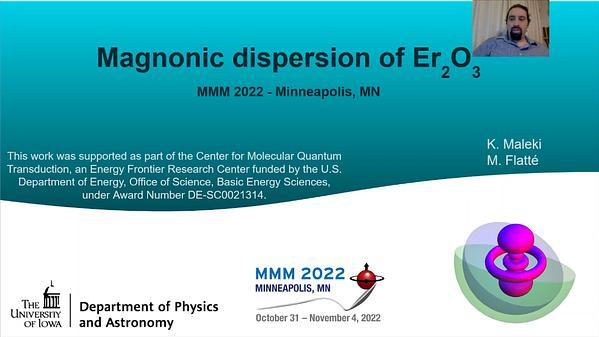Would you like to see your presentation here, made available to a global audience of researchers?
Add your own presentation or have us affordably record your next conference.
Metallic superlattices such as Co/Ir/Co exhibit the symmetric interlayer exchange coupling (IEC) (1). Recently, the antisymmetric interlayer exchange coupling (AIEC) was observed in a metallic superlattice when the in-plane spatial inversion symmetry was broken (2-5). However, the controllability and the applicability of AIEC have not been examined yet, and the systematic experiments exploiting well-controlled in-plane structural asymmetry are indispensable. This study systematically investigated the AIEC for the wedge-shaped Pt/Co/Ir/Co/Pt to clarify the nature of AIEC.
A double-wedged sample (DWS) of Ta (1)/Pt (2)/Co (tCo)/Ir (tIr)/Co (0.5)/Pt (2)/Ta (1) (thickness in nm) was deposited on a SiOx substrate using magnetron sputtering. The tCo and tIr were continuously varied from 0.6 to 1.6 nm and from 0 to 1.5 nm, respectively. The wedge direction of the Ir layer was orthogonal to that of the wedged bottom Co layer. DWS was patterned into Hall-bar-shaped devices, and the magnetic properties were investigated by exploiting the anomalous Hall effect (AHE). The IEC in Co/Ir/Co was confirmed from the periodic change of the saturation field (μ0Hs) against tIr. The AHE curves were largely shifted with an additional in-plane magnetic field (μ0Hip) of 50 mT (Fig. 1), indicating the existence of AIEC. The largest switching field shift (μ0ΔHsw) was 14.8 mT at tCo ~ 0.80 nm and tIr ~ 0.27 nm, which was an order of magnitude larger than the values reported previously (0.7~1.7 mT (3,5)). Similar to the tIr dependence of μ0Hs, μ0ΔHsw showed the oscillatory change against tIr with a local minimum at tIr ~ 0.87 nm, suggesting the correlation between the symmetric IEC and the AIEC. Furthermore, we developed the extended Stoner-Wohlfarth model and proposed the tunability of the AIEC effective field by the ratio of the AIEC energy and the antiferromagnetic coupling strength. Finally, we theoretically and experimentally demonstrated the perpendicular magnetization switching solely induced by μ0Hip for DWS. This study provides crucial information to manipulate the three-dimensional chiral magnetic structures (6).
References:
1 M. D. Stiles, J. Magn. Magn. Mater., Vol. 200, p.322-337 (1999).
2 E. Y. Vedmedenko et al., Phys. Rev. Lett., Vol. 122, p.257202 (2019).
3 D.-S. Han et al., Nat. Mater., Vol. 18, p.703 (2019).
4 A. Fernández-Pacheco et al., Nat. Mater., Vol. 18, p.679 (2019).
5 K. Wang et al., Commun., Phys. Vol. 4, p.10 (2021).
6 H. Masuda et al., Phys. Rev. Appl., Vol. 17, p.054036 (2022).

